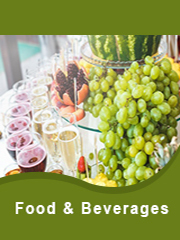Report overview
Today?s millennials are consuming tea as on-the-go beverages. According to World Tea News, in a forecast by Packaged Facts, the foodservice tea market will likely have an edge in future growth momentum as sales are expected to increase through 2018 and beyond further driving the sales of alcoholic tea market. Millennials are seeking innovation and variety when it comes to current tea offerings. The growing interest in health and wellness as well as the demand for transparently simple, whole food offerings continue to drive interest in alcoholic tea market. Innovations, underpinned by a great tasting, healthful product, means that alcoholic tea market will continue to grow in the U.S. New versions of tea-infused alcoholic beverage specialties have opened an entirely new, young alcoholic tea market. The tea-infused cocktails are becoming the hottest trending island-inspired flavors with the crisp, clear taste of premium tea on the backdrop of which the alcoholic tea market is surging at a healthy CAGR.
This report aims to provide a comprehensive presentation of the global market for Alcoholic Tea, with both quantitative and qualitative analysis, to help readers develop business/growth strategies, assess the market competitive situation, analyze their position in the current marketplace, and make informed business decisions regarding Alcoholic Tea. This report contains market size and forecasts of Alcoholic Tea in global, including the following market information:
Global Alcoholic Tea Market Revenue, 2018-2023, 2024-2029, ($ millions)
Global Alcoholic Tea Market Sales, 2018-2023, 2024-2029, (K MT)
Global top five Alcoholic Tea companies in 2022 (%)
The global Alcoholic Tea market was valued at US$ million in 2022 and is projected to reach US$ million by 2029, at a CAGR of % during the forecast period. The influence of COVID-19 and the Russia-Ukraine War were considered while estimating market sizes.
Tea is the second most consumed drink in the world, behind water. Canada, where the average tea drinker has 11 different varieties in their kitchen cupboards has a particularly progressive tea-drinking population primarily influencing the alcoholic tea market. Alcoholic ice tea are among the alcoholic teas to have hit the market in 2014 thanks to a growing on-trade trend for tea cocktails and beers. Following that trend, Scottish tea brand Eteaket, launched three tea beers this year and is preparing to unveil a fourth. Alcoholic ice tea brand Harry Brompton?s became the first to enter a UK supermarket after winning a listing for its 4% ABV tea in 56 Waitrose stores in February 2014, and the company went on winning listings in Sainsbury?s and Ocado. In November 2013, Japanese restaurant chain Wagamama became the only UK restaurant to offer iKi beer ? a ?fusion? of wheat beer and green tea.
We surveyed the Alcoholic Tea manufacturers, suppliers, distributors and industry experts on this industry, involving the sales, revenue, demand, price change, product type, recent development and plan, industry trends, drivers, challenges, obstacles, and potential risks.
Total Market by Segment:
Global Alcoholic Tea Market, by Type, 2018-2023, 2024-2029 ($ Millions) & (K MT)
Global Alcoholic Tea Market Segment Percentages, by Type, 2022 (%)
Gin
Vodka
Bourbon
Rum
Irish Cream
Others
Global Alcoholic Tea Market, by Application, 2018-2023, 2024-2029 ($ Millions) & (K MT)
Global Alcoholic Tea Market Segment Percentages, by Application, 2022 (%)
Retail
Industrial
Global Alcoholic Tea Market, By Region and Country, 2018-2023, 2024-2029 ($ Millions) & (K MT)
Global Alcoholic Tea Market Segment Percentages, By Region and Country, 2022 (%)
North America
US
Canada
Mexico
Europe
Germany
France
U.K.
Italy
Russia
Nordic Countries
Benelux
Rest of Europe
Asia
China
Japan
South Korea
Southeast Asia
India
Rest of Asia
South America
Brazil
Argentina
Rest of South America
Middle East & Africa
Turkey
Israel
Saudi Arabia
UAE
Rest of Middle East & Africa
Competitor Analysis
The report also provides analysis of leading market participants including:
Key companies Alcoholic Tea revenues in global market, 2018-2023 (Estimated), ($ millions)
Key companies Alcoholic Tea revenues share in global market, 2022 (%)
Key companies Alcoholic Tea sales in global market, 2018-2023 (Estimated), (K MT)
Key companies Alcoholic Tea sales share in global market, 2022 (%)
Further, the report presents profiles of competitors in the market, key players include:
Red Diamond
Tea Venture
Harry Brompton's London Ice Tea
Eteaket
Synergy Flavors
D?hler
Outline of Major Chapters:
Chapter 1: Introduces the definition of Alcoholic Tea, market overview.
Chapter 2: Global Alcoholic Tea market size in revenue and volume.
Chapter 3: Detailed analysis of Alcoholic Tea manufacturers competitive landscape, price, sales and revenue market share, latest development plan, merger, and acquisition information, etc.
Chapter 4: Provides the analysis of various market segments by type, covering the market size and development potential of each market segment, to help readers find the blue ocean market in different market segments.
Chapter 5: Provides the analysis of various market segments by application, covering the market size and development potential of each market segment, to help readers find the blue ocean market in different downstream markets.
Chapter 6: Sales of Alcoholic Tea in regional level and country level. It provides a quantitative analysis of the market size and development potential of each region and its main countries and introduces the market development, future development prospects, market space of each country in the world.
Chapter 7: Provides profiles of key players, introducing the basic situation of the main companies in the market in detail, including product sales, revenue, price, gross margin, product introduction, recent development, etc.
Chapter 8: Global Alcoholic Tea capacity by region & country.
Chapter 9: Introduces the market dynamics, latest developments of the market, the driving factors and restrictive factors of the market, the challenges and risks faced by manufacturers in the industry, and the analysis of relevant policies in the industry.
Chapter 10: Analysis of industrial chain, including the upstream and downstream of the industry.
Chapter 11: The main points and conclusions of the report.
